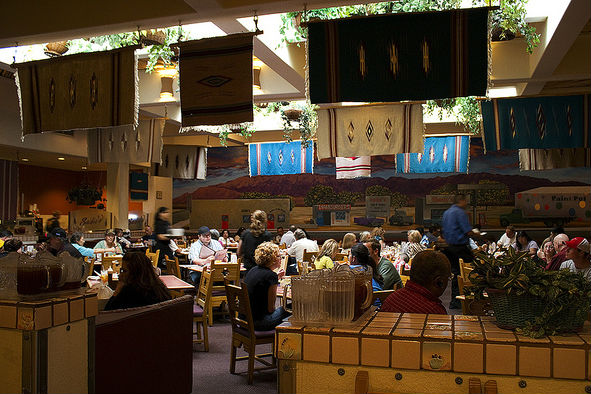Don’t call it Mexican, Tex-Mex or Spanish. New Mexican cuisine is in a class by itself. You’ll find many of familiar food elements from all of these cultures (think beans, rice and tortillas), but over the centuries, New Mexicans have blended these classic ingredients with local crops in a cooking style uniquely their own.

Inside Sadie’s of New Mexico (Photo: Rusty Gillespie via Flickr)
The region’s first inhabitants were Paleo-Indians and Native Americans. When Spanish settlers arrived, they brought with them spices from their trade routes and new cooking techniques. Later, the area became part of Mexico after the Mexican War of Independence. Finally, in 1850, it became a state after the Mexican-American War ended.
Just like its demographic, New Mexican cuisine is a fusion of cultures that have blended over many generations. Mexican and Spanish influences are apparent in staples like rice, beans and tortillas. Blue corn, a key ingredient in Native American cooking, can be seen in various forms (chips, corn tortillas, enchiladas) on menus all over town. Unlike similar styles of southwest cooking such as Tex-Mex, you won’t find much sour cream or avocado in New Mexican cuisine. The former required refrigeration, which was scarce in the old days; and avocados don’t grow in desert climates.
But the hallmark of New Mexican cuisine is chiles, the state’s largest and most profitable agricultural crop. They come in two varieties—red and green—depending on when they are harvested. Early in the season, the chile pods are bright green and much spicier. You’ll see (and smell) them being roasted at restaurants, at roadside vegetable stands and farmers markets, and in neighborhood backyards. As the chiles mature, they take on a mellower, sweeter taste and turn deep red in color. Both varieties can be made into a sauce that is used to top everything from burritos to eggs to pizza.
We explored Albuquerque neighborhood by neighborhood to find the best authentic New Mexican cuisine. Here’s what we found.
1. Biscochitos – New Mexico’s state cookie is a dainty butter version flavored with anise and cinnamon. They are usually served on special occasions such as fiestas, weddings and Christmas. You’ll find the best in the city at Golden Crown Panaderia (1103 Mountain Rd), which serves blue corn, sugar free, chocolate and cappuccino varieties in addition to the original anise flavor.
2. Salsa – “Salsa twins” Jim and John Thomas of El Pinto Restaurant (10500 4th St NW) are the undisputed salsa champs of Albuquerque. Their family recipe is so good they not only serve it in their iconic restaurant, they bottle 4,000 cases per day for retail sale. Can’t make it to Albuquerque? Look for El Pinto’s salsa at Whole Foods and other U.S. groceries.
3. Chiles – To sample New Mexico’s most famous and flavorful bounty, head to Sadie’s of New Mexico (15 Hotel Cir NE), one of Albuquerque’s oldest and most respected restaurants. Try the chile rellenos—green chile peppers stuffed with cheese, dipped in cornmeal batter and lightly fried. The chiles pack quite a bit of heat, so pair them with red sauce unless you’re a glutton for punishment.
4. Atolé – Albuquerque has a thriving farm to table food scene, thanks to its rich soil, proximity to the Rio Grande River and more than 300 days of sunshine each year. Sample atolé—a thick, comforting breakfast porridge made from blue corn—at Farm & Table (8917 4th St NW). Here, the traditional hot cereal is served with cinnamon, sugar, steamed milk and fresh fruit. (Meat eaters, add a side of bacon and thank us later. It’s locally raised and among the best we’ve ever tasted.)
5. Calabacitas – Native American influence is also seen in a popular New Mexican side dish called calabacitas. Commonly known as “the three sisters,” it’s a mix of squash, beans and corn. Not only do the three work well together in the garden (they are often grown as companion crops), they make a wonderful taste combination, too. Sample it on several dishes at Range Café (2200 Menaul Blvd).
6. Posole – This hearty pork and hominy stew is another dish commonly served at regional celebrations. And rightly so, since it takes so long to prepare. Dried white corn kernels and spices are simmered for several hours until the kernels open up, absorbing the savory broth. Traditionally, the dish is made with braised pork shoulder, but substitutions such as chicken or turkey are common. Church Street Café (2111 Church St NW) puts their spin on the dish by adding—what else—red or green chile.